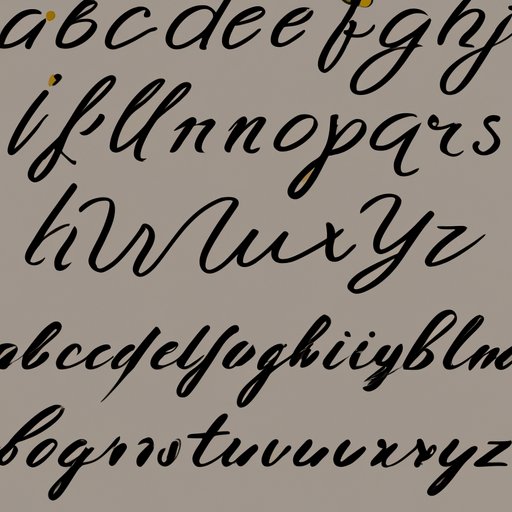Introduction
Cursive writing is a form of handwriting that connects all the letters in a word, making them flow together in a continuous stroke. It’s also referred to as script or longhand, and is often used in calligraphy. Learning how to write cursive can be a great way to express yourself creatively, and it can also help you develop better fine motor skills and hand-eye coordination.
Step-by-Step Guide to Writing Cursive
Writing in cursive can seem intimidating at first, but it doesn’t have to be. With some patience and practice, anyone can learn how to write cursive. Here are the steps to follow:
The Basic Strokes
The first step to learning how to write cursive is to learn the basic strokes. These are the fundamental shapes that make up the letters in the alphabet. Start by practicing the basic downward and upward strokes, then move on to the curves and loops. Once you feel comfortable with these strokes, you’ll be ready to move on to connecting letters.
Connecting Letters
Once you’ve practiced the basic strokes, you can start connecting letters. This is the key to writing in cursive, as it allows you to create words and phrases with a single, continuous stroke. Start by practicing simple two-letter combinations, such as “an” and “in,” then gradually work your way up to longer words.
Forming the Lowercase Alphabet
Now that you’ve mastered the basic strokes and connecting letters, it’s time to put them together to form the lowercase alphabet. Start by writing each letter separately, then practice connecting them to form words. You may find it helpful to use tracing paper or a worksheet to practice forming the letters.
Forming the Uppercase Alphabet
Once you’ve gotten the hang of writing in lowercase, you can move on to the uppercase alphabet. The uppercase letters are slightly more challenging, as they require larger strokes and more intricate loops. Take your time and practice each letter until you feel confident in your ability to write it correctly.
Creating Beautiful Cursive Letters
Once you’ve mastered the basics of writing in cursive, you can start getting creative. Here are some ideas for making your cursive writing stand out:
Designing Your Own Cursive Font
Creating your own unique font is a great way to make your cursive writing stand out. Experiment with different sizes and shapes of letters to create a font that reflects your personal style.
Adding Flourishes
Adding flourishes to your cursive letters is an easy way to give them an extra touch of flair. Try adding swirls and curls to the ends of letters, or draw small decorations within the letters themselves.
Enhancing Your Letters with Color
Adding color to your cursive writing can give it a more vibrant and eye-catching look. Try using colored pencils, markers, or even paint to bring your letters to life.
Practice Makes Perfect: How to Master Cursive Writing
Learning how to write in cursive takes time and practice. Here are some tips for mastering this skill:
Setting Aside Time for Practice
The key to mastering cursive writing is to set aside time for regular practice. Aim for at least 15 minutes of practice each day to ensure that you’re making progress.
Making Mistakes and Learning From Them
Writing in cursive can be tricky, so don’t be afraid to make mistakes. Use your mistakes as an opportunity to learn and grow, and you’ll be writing beautifully in no time.
Using Online Resources for Practice
There are plenty of online resources available to help you practice your cursive writing. Look for websites and apps that provide tracing exercises, worksheets, and other tools to help you hone your skills.
Tips & Tricks for Writing in Cursive
Writing in cursive can be tricky, so here are some useful tips and tricks to keep in mind:
Utilizing Tracing Paper
Using tracing paper is a great way to practice your cursive writing without having to worry about making mistakes. Place the tracing paper over a sample of cursive writing, then trace the letters with your pencil.
Using a Pencil Grip
Using a pencil grip can help you maintain proper posture while writing in cursive. A pencil grip ensures that your fingers are in the correct position, making it easier to write neatly and comfortably.
Keeping Your Paper at an Angle
When writing in cursive, it’s important to keep your paper at an angle. This will help you keep your letters consistent and make it easier to connect them.
A Beginner’s Guide to Writing Cursive
If you’re just starting out with cursive writing, here are some tips to help you get started:
Starting with Simple Words
It can be overwhelming to try to dive right into writing full sentences in cursive. Instead, start by practicing simple words, such as “cat” and “dog.” Once you’ve mastered these words, you can move on to longer words and sentences.
Building Up to More Difficult Words
Once you’ve gotten the hang of writing simple words, you can start to challenge yourself by attempting more difficult words. Try writing words with more complicated letter combinations, such as “friend” and “beautiful.”
Taking Breaks While Writing
Writing in cursive can be tiring, so it’s important to take breaks while you’re practicing. Give your hands a break every few minutes to prevent fatigue and allow your muscles to rest.
Conclusion
Learning how to write in cursive can be a fun and rewarding experience. With some patience and practice, anyone can master this skill. Remember to start with the basics, practice connecting letters, and take breaks when needed.
(Note: Is this article not meeting your expectations? Do you have knowledge or insights to share? Unlock new opportunities and expand your reach by joining our authors team. Click Registration to join us and share your expertise with our readers.)
